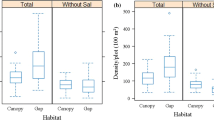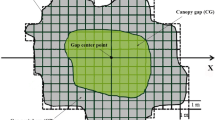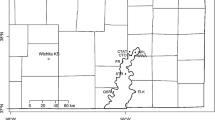Abstract
We examined the influence of small-scale gap disturbances on stand development and tree species coexistence in an old-growth Fagus sylvatica–Abies alba forest in the Dinaric Mountains of Bosnia–Herzegovina. The structure and composition of tree regeneration in gaps were compared to the forest as a whole, and the influence of gap size on the density and composition of regeneration was assessed. Transition probabilities were also calculated from gapfillers in different life stages to examine canopy replacement patterns. The structure and composition of tree regeneration were similar between gaps and the forest as a whole, and there was no relationship between overall regeneration density and gap size, indicating most individuals established prior to gap formation. Likewise, there was no strong evidence of gap-size partitioning for shade tolerant F. sylvatica and A. alba, although less tolerant Acer pseudoplatanus only recruited to taller life stages in larger gaps. Transition probabilities calculated from the seedling and sapling data suggest that most gaps will be captured by F. sylvatica, while probabilities based on pole-sized gapmakers indicate both A. alba and F. sylvatica will be maintained in the canopy. We suggest that gaps primarily play a role in reorganizing advance regeneration, and that coexistence of shade tolerant F. sylvatica and A. alba is more likely related to their differential ability to tolerate shaded understory conditions, particularly during larger life stages, rather than gap-size partitioning.



Similar content being viewed by others
References
Ammer C (1996) Konkurrenz um Licht. Zur Entwicklung der Naturverjüngung im Bergmischwald. Forstliche Forschungsberichte München 158: 198 pp
Anonymous (2004) Game management plan for Sutjeska National Park, Bosnia and Herzegovina
Barden LS (1981) Forest development in canopy gaps of a diverse hardwood forest of the southern Appalachian Mountains. Oikos 37:205–209
Battles JJ, Fahey TJ (2000) Gap dynamics following forest decline: a case study of red spruce forests. Ecol Appl 10:760–774
Brokaw NVL (1985) Gap-phase regeneration in a tropical forest. Ecology 66:682–687
Burschel P, Kateb H, Huss J, Mosandl R (1985) Die Verjüngung im Bergmischwald. Forstwiss Cent bl 104: 65–100
Busing RT (1996) Estimation of tree replacement patterns in an Appalachian Picea-Abies forest. J Veg Sci 7:685–694
Busing RT, White PS (1997) Species diversity and small-scale disturbance in an old-growth temperate forest: a consideration of gap partitioning concepts. Oikos 78:562–568
Canham CD (1989) Different responses to gaps among shade-tolerant tree species. Ecology 70:548–550
Canham CD, Finzi AC, Pacala SW, Burbank DH (1994) Causes and consequences of resource heterogeneity in forests—interspecific variation in light transmission by canopy trees. Can J For Res 24:337–349
de Römer AH, Kneeshaw DD, Bergeron Y (2007) Small gap dynamics in the southern boreal forest of eastern Canada: do canopy gaps influence stand development? J Veg Sci 18:815–826
Denslow JS (1980) Gap partitioning among tropical rainforest trees. Biotropica 12:47–55
Denslow JS (1995) Disturbance and diversity in tropical rain-forests—the density effect. Ecol Appl 5:962–968
Drösser L, von Lüpke B (2005) Canopy gaps in two virgin beech forest reserves in Slovakia. J For Sci 51:446–457
Ellenberg HH (1988) Vegetation ecology of central Europe. Cambridge University Press, Cambridge, UK
Ferlin F (2002) The growth potential of understorey silver fir and Norway spruce for uneven-aged forest management in Slovenia. Forestry 75:375–383
Finzi AC, Van Breemen N, Canham CD (1998) Canopy tree soil interactions within temperate forests: species effects on soil carbon and nitrogen. Ecol Appl 8:440–446
Firm D, Nagel TA, Diaci J (2009) Disturbance history and dynamics of an old-growth mixed species mountain forest in the Slovenian Alps. For Ecol Manag 257:1893–1901
Fox JF (1977) Alternation and coexistence of tree species. Am Nat 111:69–89
Frelich LE, Reich PB (1995) Spatial patterns and succession in a Minnesota southern-boreal forest. Ecol Monogr 65:325–346
Fukarek P (1970) Sumske zajednice prasumskog rezervata Perucica u Bosni. In: Fukarek P (ed) Simpozijum juznoevpropske prasume i viso-koplaninska flora i vegetatija istocnoalpsko-dinarskog prostora. redovni clan akademije nauka i umjetnosti Bosne i Hercegovine, Sarajevo, pp 157–262
Fukarek P, Stefanovic V (1958) Prasuma Perucica i njena vegetacija. Sarajevo
Givnish TJ (1988) Adaptation to sun and shade—a whole-plant perspective. Aus J Plant Physiol 15:63–92
Grubb PJ (1977) Maintenance of species-richness in plant communities—importance of regeneration niche. Biol Rev 52:107–145
Gutierrez AG, Aravena JC, Carrasco-Farias NV, Christie DA, Fuentes M, Armesto JJ (2008) Gap-phase dynamics and coexistence of a long-lived pioneer and shade-tolerant tree species in the canopy of an old-growth coastal temperate rain forest of Chiloe Island, Chile. J Biogeogr 35:1674–1687
Hättenschwiler S (2001) Tree seedling growth in natural deep shade: functional traits related to interspecific variation in response to elevated CO2. Oecologia 129:31–42
Hein S, Collet C, Ammer C, Le Goff N, Skovsgaard JP, Savill P (2009) A review of growth and stand dynamics of Acer pseudoplatanus L. in Europe: implications for silviculture. Forestry 82:361–385
Hubbell SP, Foster RB, O’Brien ST, Harms KE, Condit R, Wechsler B, Wright SJ, de Lao SL (1999) Light-gap disturbances, recruitment limitation, and tree diversity in a neotropical forest. Science 283:554–557
Klopcic M, Jerina K, Boncina A (2010) Long-term changes of structure and tree species composition in Dinaric uneven-aged forests: are red deer an important factor? Eur J Forest Res. doi:10.1007/s10342-009-0325-z
Kneeshaw DD, Prevost M (2007) Natural canopy gap disturbances and their role in maintaining mixed-species forests of central Quebec, Canada. Can J For Res 37:1534–1544
Kneeshaw DD, Kobe RK, Coates KD, Messier C (2006) Sapling size influences shade tolerance ranking among southern boreal tree species. J Ecol 94:471–480
Kobe RK, Pacala SW, Silander JA, Canham CD (1995) Juvenile tree survivorship as a component of shade tolerance. Ecol Appl 5:517–532
Lertzman KP (1992) Patterns of gap-phase replacement in a sub-Alpine, old-growth forest. Ecology 73:657–669
Lertzman KP (1995) Forest dynamics, differential mortality and variable recruitment probabilities. J Veg Sci 6:191–204
Lieberman M, Lieberman D, Peralta R (1989) Forests are not just Swiss cheese—canopy stereogeometry of non-gaps in tropical forests. Ecology 70:550–552
Lusk CH (2004) Leaf area and growth of juvenile temperate evergreens in low light: species of contrasting shade tolerance change rank during ontogeny. Funct Ecol 18:820–828
Lusk CH, Smith B (1998) Life history differences and tree species coexistence in an old-growth New Zealand rain forest. Ecology 79:795–806
Mayer H (1984) Waldbau auf soziologisch-ökologischer Grundlage. Gustav Fischer Verlag, Stuttgart
Messier C, Doucet R, Ruel JC, Claveau Y, Kelly C, Lechowicz MJ (1999) Functional ecology of advance regeneration in relation to light in boreal forests. Can J For Res 29:812–823
Mlinsek D (1967) Rast in sposobnost reagiranja pragozdne bukve. Zbornik Biotehniske fakultete 15:63–79
Nagel TA, Diaci J (2006) Intermediate wind disturbance in an old-growth beech-fir forest in southeastern Slovenia. Can J For Res 36:629–638
Nagel TA, Svoboda M (2008) Gap disturbance regime in an old-growth Fagus–Abies forest in the Dinaric Mountains, Bosnia–Herzegovina. Can J For Res 38:2728–2737
Nagel TA, Svoboda M, Diaci J (2006) Regeneration patterns after intermediate wind disturbance in an old-growth Fagus–Abies forest in southeastern Slovenia. For Ecol Manag 226:268–278
Nagel TA, Levanic T, Diaci J (2007) A dendroecological reconstruction of disturbance in an old-growth Fagus–Abies forest in Slovenia. Ann For Sci 64:891–897
Petritan AM, Von Luepke B, Petritan IC (2007) Effects of shade on growth and mortality of maple (Acer pseudoplatanus), ash (Fraxinus excelsior) and beech (Fagus sylvatica) saplings. Forestry 80:397–412
Pintaric K (1978) Urwald Perucica als natürliches Forschungslaboratorium. Allgemeine Forst Zeitschrift 24:702–707
Piovesan G, Di Filippo A, Alessandrini A, Biondi F, Schirone B (2005) Structure, dynamics and dendroecology of an old-growth Fagus forest in the Apennines. J Veg Sci 16:13–28
Poulson TL, Platt WJ (1996) Replacement patterns of beech and sugar maple in Warren Woods, Michigan. Ecology 77:1234–1253
Preuhsler T (1989) Die Entwicklung von Oberstand und Naturverjüngung in Bergmischwald-Verjüngungsbeständen des Forstamtes Kreuth. Centralblatt für das gesamte forstwesen 106:23–54
Prpic B, Matic S, Vukelic J, Seletkovic Z (2001) Virgin forests of beech and fir in the Croatian Dinaric Mountain range. In: Prpic B (ed) Silver Fir in Croatia. Akademija sumarskih znanosti—Hrvatske sume, Zagreb, pp 493–500
Rebertus AJ, Veblen TT (1993) Structure and tree-fall gap dynamics of old-growth Nothofagus forests in Tierra-Del-Fuego, Argentina. J Veg Sci 4:641–654
Rozenbergar D, Mikac S, Anic I, Diaci J (2007) Gap regeneration patterns in relationship to light heterogeneity in two old-growth beech-fir forest reserves in South East Europe. Forestry 80:431–443
Runkle JR (1981) Gap regeneration in some old-growth forests of the eastern United States. Ecology 62:1041–1051
Runkle JR (1982) Patterns of disturbance in some old-growth Mesic Forests of Eastern North America. Ecology 63:1533–1546
Schnitzer SA, Carson WP (2001) Treefall gaps and the maintenance of species diversity in a tropical forest. Ecology 82:913–919
Seiwa K (2007) Trade-offs between seedling growth and survival in deciduous broadleaved trees in a temperate forest. Ann Bot 99:537–544
Stancioiu PT, O’Hara KL (2006) Regeneration growth in different light environments of mixed species, multiaged, mountainous forests of Romania. Eur J For Res 125:151–162
Stewart GH, Rose AB, Veblen TT (1991) Forest development in canopy gaps in old-growth beech (Nothofagus) forests, New Zealand. J Veg Sci 2:679–690
Szewczyk J, Szwagrzyk J (1996) Tree regeneration on rotten wood and on soil in old-growth stand. Vegetatio 122:37–46
Szwagrzyk J, Szewczyk J (2008) Is natural regeneration of forest stands a continuous process? A case study of an old-growth forest of the western Carpathians. Pol J Ecol 56:623–634
Szwagrzyk J, Szewczyk J, Bodziarczyk J (2001) Dynamics of seedling banks in beech forest: results of a 10-year study on germination, growth and survival. For Ecol Manag 141:237–250
Szymura TH (2005) Silver fir sapling bank in seminatural stand: individuals architecture and vitality. For Ecol Manag 212:101–108
Taylor AH (1990) Disturbance and persistence of Sitka spruce (Picea-sitchensis (Bong.) Carr.) in coastal forests of the pacific northwest, North America. J Biogeogr 17:47–58
Uhl C, Clark K, Dezzeo N, Maquirino P (1988) Vegetation dynamics in Amazonian treefall gaps. Ecology 69:751–763
Valladares F, Niinemets U (2008) Shade tolerance, a key plant feature of complex nature and consequences. Annu Rev Ecol Evol Syst 39:237–257
Veblen TT (1986) Treefalls and the coexistence of conifers in sub-alpine forests of the central Rockies. Ecology 67:644–649
Webb SL, Scanga SE (2001) Windstorm disturbance without patch dynamics: twelve years of change in a Minnesota forest. Ecology 82:893–897
White PS, Mackenzie MD, Busing RT (1985) A critique on overstory understory comparisons based on transition-probability analysis of an old growth spruce-fir stand in the Appalachians. Vegetatio 64:37–45
Whitmore TC (1989) Canopy gaps and the two major groups of forest trees. Ecology 70:536–538
Woods KD (1984) Patterns of tree replacement: canopy effects on understory pattern in hemlock-northern hardwood forests. Vegetatio 56:87–107
Acknowledgments
This study was funded by the Slovenian Research Agency (ARRS). Miroslav Svoboda received support from the project VaV MZP SP/2d2/111/08. We are grateful to the park administration of Sutjeska National Park for providing access to the Perucica forest reserve. We thank Katrine Hahn Kristensen and Anders Busse Nielsen for help with field sampling, and two anonymous reviewers for providing helpful critiques of an earlier version of this manuscript.
Author information
Authors and Affiliations
Corresponding author
Rights and permissions
About this article
Cite this article
Nagel, T.A., Svoboda, M., Rugani, T. et al. Gap regeneration and replacement patterns in an old-growth Fagus–Abies forest of Bosnia–Herzegovina. Plant Ecol 208, 307–318 (2010). https://doi.org/10.1007/s11258-009-9707-z
Received:
Accepted:
Published:
Issue Date:
DOI: https://doi.org/10.1007/s11258-009-9707-z




